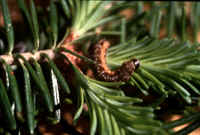Spruce budworm outbreaks
 Although
part of the FERLD has not burned since 1760, it has been affected by other
disturbances, including timber harvesting and, more importantly, several
spruce budworm (Choristoneura
fumiferana) outbreaks. Three outbreaks, occurring at intervals of
25 to 30 years, have occurred in this area during the twentieth century
(Morin et al., 1993). Spruce budworm larvae feed on the young needles
of balsam fir and spruce, although balsam fir is by far the most vulnerable
species. Although
part of the FERLD has not burned since 1760, it has been affected by other
disturbances, including timber harvesting and, more importantly, several
spruce budworm (Choristoneura
fumiferana) outbreaks. Three outbreaks, occurring at intervals of
25 to 30 years, have occurred in this area during the twentieth century
(Morin et al., 1993). Spruce budworm larvae feed on the young needles
of balsam fir and spruce, although balsam fir is by far the most vulnerable
species.
The vast majority of mature fir trees in the area were killed during the most recent
epidemic, which lasted from 1970 to 1987 and it’s still possible to see many standing
dead trees (fig. 1; Bergeron
et al., 1995). Fir mortality varies greatly from one stand type to another, with
coniferous stands being more affected than hardwood or mixed stands.

Fig. 1. Raw mortality of balsam fir in relation to the time elapsed
since the last fire from which the stands originated. Box plots portray
the median (midbar in the box) and the 10th, 25th, 75th and 90th percentiles.
Asterisks show the mean values.
|
Nonetheless, it is possible to observe greatly
reduced levels of defoliation and mortality in small coniferous islands (fig 2). Although
no data exist concerning local spruce budworm abundance during the last oubreak, current
population densities do not appear to be linked to a stand’s ecological location
(site type). As well, isolated stands do not avoid budworm damage because of their
distance from continuous coniferous stands. Rather, the rate of budworm parisitism has
been found to be significantly higher in isolated softwood stands surrounded by hardwoods
(Cappuccino et al,
1998). Budworm mortality during larval development may therefore result in reduced
defoliation levels and lower tree mortality in these situations. Gaps created by spruce
budworm outbreaks may cover large areas, depending on the abundance of balsam fir in the
stand. Fir seedlings are only rarely affected by the budworm and are generally the most
abundant species in the regeneration layer. As a result, they will usually replace the
dead overstory fir and form the next stand. However, the presence of extremely large gaps,
as found in older coniferous stands, may result in a decrease in fir density, to the
advantage of other species such as aspen, cedar and shrubs.

Fig. 2. Comparison of balsam fir mortality (%) occuring in three different
spatial contexts.
|

|